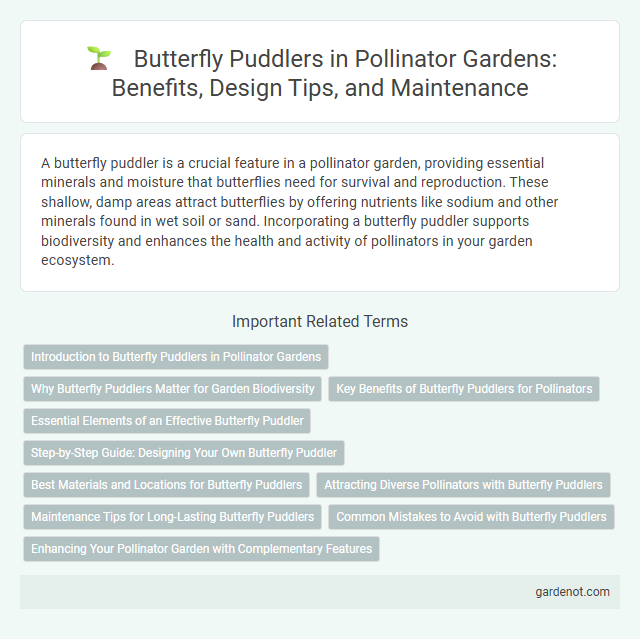A butterfly puddler is a crucial feature in a pollinator garden, providing essential minerals and moisture that butterflies need for survival and reproduction. These shallow, damp areas attract butterflies by offering nutrients like sodium and other minerals found in wet soil or sand. Incorporating a butterfly puddler supports biodiversity and enhances the health and activity of pollinators in your garden ecosystem.
Introduction to Butterfly Puddlers in Pollinator Gardens
Butterfly puddlers are shallow, moist areas designed to attract butterflies by providing essential minerals and hydration. These specialized garden features create a habitat where butterflies gather to sip water enriched with salts and nutrients critical for their survival and reproduction. Incorporating butterfly puddlers enhances pollinator gardens by supporting butterfly health and increasing pollination activity.
Why Butterfly Puddlers Matter for Garden Biodiversity
Butterfly puddlers attract butterflies by providing essential moisture and minerals from damp soil or sand, supporting their hydration and nutrition needs critical for survival and reproduction. These puddling sites enhance garden biodiversity by encouraging a variety of butterfly species to visit, pollinate plants, and contribute to a balanced ecosystem. Maintaining butterfly puddlers promotes pollinator health and assists in sustaining diverse plant populations within pollinator gardens.
Key Benefits of Butterfly Puddlers for Pollinators
Butterfly puddlers provide essential nutrients such as salts and minerals crucial for butterfly metabolism and reproduction, enhancing their overall health and longevity. These moist, sandy areas attract diverse pollinator species, supporting local biodiversity and promoting ecosystem resilience. By facilitating nutrient uptake, butterfly puddlers contribute to improved pollination rates, aiding in the growth and reproduction of various flowering plants.
Essential Elements of an Effective Butterfly Puddler
An effective butterfly puddler incorporates moist, sandy soil rich in essential minerals like sodium and calcium to provide vital nutrients for butterflies. Shallow water sources with fine-grained substrates enable butterflies to extract moisture and salts efficiently. Proper placement in sunny, sheltered locations enhances accessibility and encourages frequent butterfly visits, supporting their hydration and reproductive behaviors.
Step-by-Step Guide: Designing Your Own Butterfly Puddler
Create a butterfly puddler by selecting a shallow container filled with a mix of sand, soil, and water to mimic natural mud puddles that provide essential minerals for butterflies. Position the puddler in a sunny, sheltered spot near nectar-rich flowers to attract a variety of butterfly species and ensure consistent moisture by regularly topping up water. Incorporate flat stones or leaves around the puddler to offer resting places and improve accessibility for butterflies seeking nutrients.
Best Materials and Locations for Butterfly Puddlers
Butterfly puddlers thrive in damp, sandy soils enriched with organic matter to provide essential minerals for butterfly feeding. Ideal locations include sunny, sheltered areas near flowering plants and shallow water sources, where butterflies can easily access the mud to obtain nutrients. Using unpainted clay pots or shallow trays filled with a mixture of sand, mud, and a small amount of compost replicates natural puddling sites and attracts diverse butterfly species.
Attracting Diverse Pollinators with Butterfly Puddlers
Butterfly puddlers provide essential minerals and moisture, attracting diverse pollinators such as butterflies, bees, and other beneficial insects to pollinator gardens. These shallow, damp areas mimic natural puddling sites where butterflies gather to extract nutrients vital for reproduction and longevity. Incorporating butterfly puddlers enhances pollinator diversity and supports ecosystem health by promoting effective pollination.
Maintenance Tips for Long-Lasting Butterfly Puddlers
Regularly replenish butterfly puddlers with fresh, damp sand or soil mixed with minerals like salt or clay to attract and sustain butterflies. Ensure the area remains moist but not waterlogged by watering lightly during dry periods, promoting butterfly visitation and nutrient uptake. Remove debris and prevent mold buildup by cleaning the puddler surface weekly, maintaining an inviting environment for long-lasting butterfly activity.
Common Mistakes to Avoid with Butterfly Puddlers
Butterfly puddlers often suffer from overwatering, which can wash away essential minerals butterflies seek for nourishment. Placing puddlers in direct, harsh sunlight may deter butterflies and reduce usage, so providing a partially shaded area enhances effectiveness. Using chemically treated soil or fertilizers near puddling sites can harm butterflies, making it crucial to use organic, pesticide-free materials.
Enhancing Your Pollinator Garden with Complementary Features
Incorporating a butterfly puddler into your pollinator garden provides essential minerals and hydration that attract diverse butterfly species, boosting overall garden biodiversity. This shallow water feature with moist soil or sand creates a natural habitat conducive to butterfly puddling behavior, supporting their survival and reproduction. Position the puddler near nectar-rich plants and sunny spots to maximize butterfly visitation and enhance pollination efficiency.
Butterfly puddler Infographic

 gardenot.com
gardenot.com